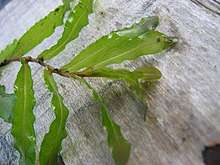Potamogeton crispus
Potamogeton crispus, the curled pondweed or curly-leaf pondweed, is a species of aquatic plant native to Eurasia but an introduced species and often a noxious weed in North America.

| Potamogeton crispus | |
|---|---|
 | |
| Scientific classification | |
| Kingdom: | Plantae |
| Clade: | Tracheophytes |
| Clade: | Angiosperms |
| Clade: | Monocots |
| Order: | Alismatales |
| Family: | Potamogetonaceae |
| Genus: | Potamogeton |
| Species: | P. crispus |
| Binomial name | |
| Potamogeton crispus | |
Description
Curly-leaf pondweed is a rhizomatous perennial herb producing a flattened, branching stem up to a meter long. The leaves are linear or oblong in shape. Only submerged leaves are produced, which are sessile, linear or oblong in shape, 25–95 mm long and 5–12 mm wide.[1] The leaves may be bright green, olive green or (especially later in the season) brownish and have noticeably serrated margins, a feature that distinguishes them from other pondweeds. The leaves usually have wavy edges but this is not always apparent, especially on new growth.[1] Turions occur in leaf axils and at stem tips.
The inflorescence is a short spike of flowers emerging above the water surface. It flowers from May until October.[2]
The turions of the plant develop along with the fruits and germinate, leaving the newly sprouted plants to overwinter.[3]
Although quite variable, P. crispus is usually a straightforward plant to identify. Hybrids with various other pondweeds are recorded, but these do not usually closely resemble P. crispus.
There are described hybrids with Potamogeton trichoides (P. × bennettii Fryer), P.perfoliatus (P. × cooperi (Fryer) Fryer), P. alpinus (P. × olivaceus Baagøe ex G.Fisch.), P.lucens (P. × cadburyae Dandy & G.Taylor), P. praelongus (P. × undulatus Wolgf.), P. ochreatus (P. × jacobsii Z.Kaplan, Fehrer & Hellq.) and P. friesii (P. × lintonii Fryer).[4]
Distribution
Potamogeton crispus is native to a wide range of countries in Asia (Afghanistan, Bangladesh, Bhutan, China, India, Indonesia (Sumatra), Japan, Kazakhstan, Korea, Kyrgyzstan, Laos, Mongolia, Myanmar, Nepal, Pakistan, Russia, Tajikistan, Thailand, Turkmenistan, Uzbekistan, Vietnam); Africa, the Middle East, Australia, and Europe.[5] It has been introduced to the Americas and New Zealand.
Ecology
Curly pondweed is widespread and common across most of its native range, growing in standing and slow-flowing water including small ponds and ditches. It is strictly a lowland plant and requires fine substrates in standing or slow-flowing calcareous water. However, it is tolerant of significant nutrient pollution, and this has allowed it to persist in intensively farmed areas where more sensitive pondweeds have declined. Its production of both seed and turions makes it resistant to disturbance such as dredging, in contrast to some of the larger broad-leaved pondweeds.
Environmental impact
This pondweed is considered an invasive species in much of North America. It was introduced to the Great Lakes and inland lakes within that region. The plant thrives in conditions normally less habitable to native plant species. It competes with native plant life and sometimes displaces it. Curly pondweed may clog waterways, inhibiting aquatic recreation and is considered a nuisance in some areas. It has also been introduced to South America and New Zealand.[5]
Cultivation
Potamogeton crispus is sometimes cultivated as a pond plant, and generally speaking makes a good garden plant. Since it starts to die back rather early, it is probably a good idea to cut it back in July after it has flowered. In common with other pondweeds of this group it roots poorly from stem cuttings and is best propagated by division of the rhizomes or from turions. As it has proved invasive in some areas, curly pondweed should not be grown outside its native range.
References
- Preston C. D. (1995) Pondweeds of Great Britain and Ireland. BSBI Handbook No. 8. Botanical Society of the British Isles, London.
- Rose, Francis (2006). The Wild Flower Key. Frederick Warne & Co. pp. 491–492. ISBN 978-0-7232-5175-0.
- Flora of North America
- The Plant List: Potamogeton crispus. Royal Botanic Gardens, Kew and Missouri Botanic Gardens. Accessed November 18, 2014
- Guo Y., Haynes R. R., Hellquist C. B., Kaplan Z. 2010. Potamogeton. Flora of China, 23, 108-114. http://www.efloras.org/florataxon.aspx?flora_id=2&taxon_id=10726
External links
- Jepson Manual Treatment
- Washington Burke Museum
- Photo gallery
- GLANSIS Species FactSheet
- Species Profile- Curly Pondweed (Potamogeton crispus), National Invasive Species Information Center, United States National Agricultural Library. Lists general information and resources for Curly Pondweed.